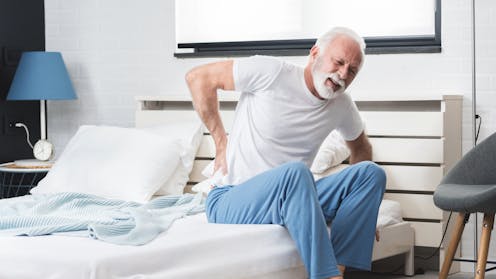Why your doctor may not have given you the best advice for your lower back pain
Focus and Blur/Shutterstock.com
Treating lower back pain is enormously expensive. In the UK it’s estimated to cost the NHS around £3.2 billion a year. So, ensuring patients get the right treatment is critical.
However, the guidance issued by the UK’s National Institute for Health and Care Excellence (Nice) on how to treat lower back pain was last updated in 2020, meaning many patients may be getting out-of-date advice from their healthcare practitioner.
Fortunately, most people with lower back pain recover quickly without treatment. But a minority don’t, and they can go on to develop long-term disability.
People with lower back pain usually see their GP first. The GP may refer the patient to a physiotherapist, or, in some parts of the UK, patients can refer themselves to one.
Get your news from actual experts, straight to your inbox. Sign up to our daily newsletter to receive all The Conversation UK’s latest coverage of news and research, from politics and business to the arts and sciences.
However, Nice recommends using a short questionnaire to identify those least likely to recover, so they can be offered more intensive treatment. Those most likely to recover get an initial assessment and advice only.
This approach was supported by a UK study which found a small benefit compared to offering everyone standard physiotherapy care. But later studies have not confirmed that result. It may not matter if care is targeted at those at highest risk or not.
Nice also recommends self-management. This means giving patients information and leaving them to handle their own recovery. But recent research found that an online support programme was no better than usual care from their GP.
For people with at least three months of lower back pain, Nice recommends “radio frequency denervation” as an option. This is a procedure where a probe is inserted into the back next to the nerve carrying pain signals from the back. Heating the probe can disable the nerves that carry pain signals. The problem is that some studies suggest it may help while others show no benefit.
A more robust study is underway that will hopefully provide us with a more definitive answer. But, for now, we think this treatment should be approached with caution.
Most Nice recommendations for the use of medications align with the current evidence. Nice recommends against the use of opioids for people with short-term back pain. However, the guidance suggests that weak opioids, such as codeine, can be considered if anti-inflammatory drugs are ineffective or “contraindicated” (should be avoided), for example, for people with previous stomach bleeding.
This ambiguous approach is confusing and may result in people being given the wrong care. Also, a study published in 2023 showed that a stronger opioid does not help people with short-term back pain. Nice could adopt a clearer stance, explicitly discouraging opioid use for lower back pain.
The guidance could focus on treatments where there’s strong evidence of benefit. One option is non-steroidal anti-inflammatory drugs, such as ibuprofen, which can be effective for treating people with acute and persistent symptoms. If this medication fails, heat therapy, such as hot packs and heat wraps, can be used for short-term lower back pain.
Nice suggests that codeine can be used if the patient is unable to take anti-inflammatory medication, such as ibuprofen.
Matthew Nichols1/Shutterstock.com
Treating peristant lower back pain
Exercise programmes can help people with persistent back pain. A recent study found that regular walking can help prevent lower back pain flare-ups.
Approaches, such as cognitive functional therapy, where physiotherapists address both physical and psychological barriers to recovery, also show great promise. A recent study found that it offers lasting benefits when compared to a sham (placebo) intervention.
Mindfulness, a type of meditation, also seems a promising approach for persistent pain. A new study, published in The Lancet Rheumatology showed that it can have meaningful and lasting benefits for these patients.
Guidance from the World Health Organization recommends other treatments, such as manual therapy (spinal manipulation, for instance) and acupuncture, that could help people with persistent symptoms.
It is clear that the Nice guidelines don’t always reflect what we now know works, and sometimes steer care in the wrong direction.
Martin Underwood is chief investigator or co-investigator on multiple previous and current research grants from the UK National Institute for Health Research, and is a co-investigator on grants funded by the Australian NHMRC and Norwegian MRC. He is a director and shareholder of Clinvivo Ltd that provides electronic data collection for health services research. He has accepted honoraria for examining theses, and performing peer review. He receives some salary support from University Hospitals Coventry and Warwickshire. He is a co-investigator on two current and one completed NIHR funded studies that have, or have had, additional support from Stryker Ltd. He has accepted travel expenses and accommodation for speaking at academic meetings.
Gustavo Machado has an investigator grant from the National Health and Medical Research Council. He also holds research grants from the National Health and Medical Research Council, Medical Research Future Fund, and HCF Research Foundation.
Crystian Bitencourt Soares de Oliveira does not work for, consult, own shares in or receive funding from any company or organisation that would benefit from this article, and has disclosed no relevant affiliations beyond their academic appointment.


